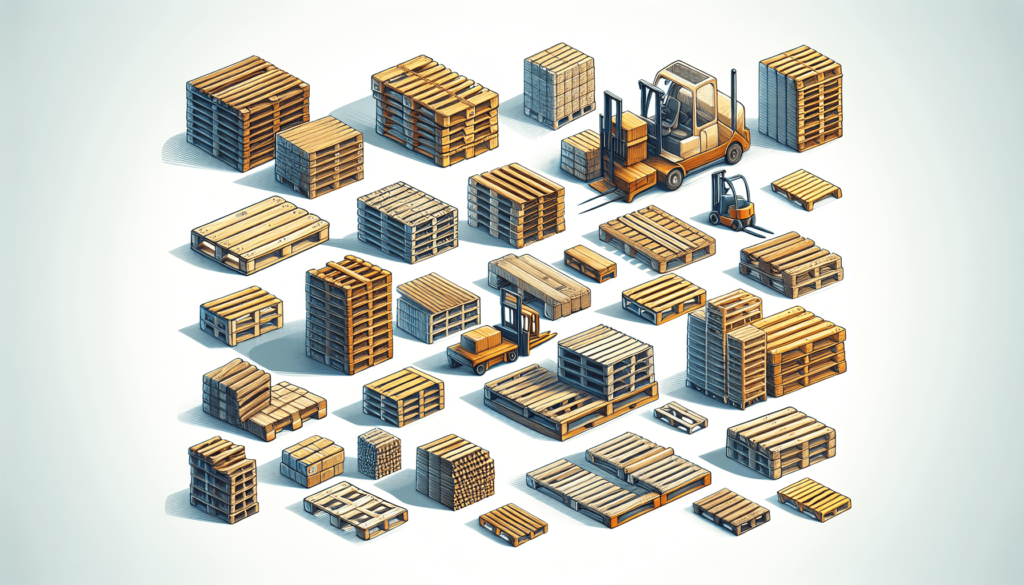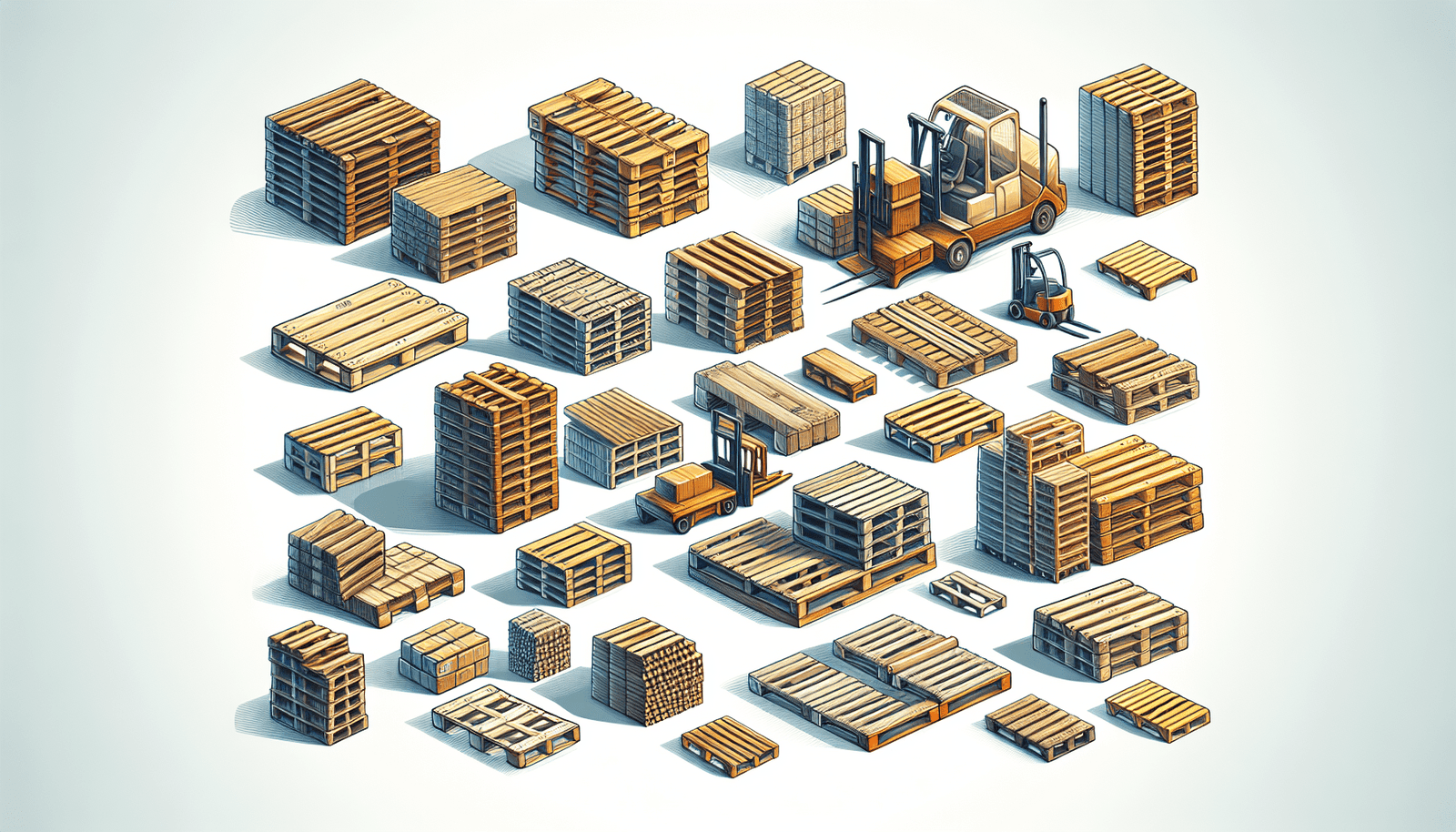Have you ever wondered which pallets are the most valuable? In a world where pallets are essential for transporting goods, it’s fascinating to discover which ones hold the greatest worth. Whether you’re in the business of buying, selling, or simply curious about the economics behind pallets, this article will unveil the secrets behind the most valuable pallets on the market. From the exotic to the unexpected, prepare to be amazed by the world of high-value pallets!
Types of Pallets
When it comes to pallets, there are various types available in the market. Each type has its own unique characteristics and is suitable for different purposes. In this article, we will explore the different types of pallets and discuss their composition, common applications, market value range, and their pros and cons.
Standard Pallets
Standard pallets are the most commonly used type of pallets in the industry. These pallets are typically made from wood and are designed to be versatile and durable. They come in various sizes, with the most common size being 48 inches by 40 inches. Standard pallets are widely used in industries such as warehousing, logistics, and manufacturing.
In terms of market value range, standard pallets can vary depending on factors such as condition, size, and material. On average, standard pallets can range anywhere from $10 to $50 per pallet, although prices may vary depending on market demand and geographic location.
The pros of using standard pallets include their widespread availability, ease of repair, and compatibility with most pallet handling equipment. However, one drawback is that they can be prone to damage and wear over time, especially if not properly handled or stored.
Euro Pallets
Euro pallets, also known as EUR pallets, are widely used in Europe and have become increasingly popular in other parts of the world as well. These pallets follow a standardized design and are typically made from hardwood, although some variations use softwood or composite materials.
Euro pallets are known for their durability and uniformity. They have a standard size of 47.24 inches by 31.50 inches, making them suitable for efficient use of space. Euro pallets are commonly used in industries such as retail, food, and pharmaceuticals.
In terms of market value range, Euro pallets tend to be on the higher end compared to standard pallets. On average, Euro pallets can range from $20 to $80 per pallet, depending on factors such as condition, demand, and location.
The advantages of Euro pallets include their uniformity, which allows for easy stacking and handling, and their durability, which ensures a longer lifespan. However, their higher cost compared to standard pallets can be a deterrent for some businesses.
Plastic Pallets
Plastic pallets, as the name suggests, are made from plastic materials such as high-density polyethylene (HDPE) or polypropylene (PP). These pallets offer several advantages over their wooden counterparts, including resistance to moisture, chemicals, and pests. They are also lightweight and easy to clean.
Plastic pallets are commonly used in industries that require strict hygiene standards, such as pharmaceuticals, food processing, and healthcare. They are also widely used in export and shipping due to their resistance to moisture and the ability to meet international regulations regarding wood treatment.
In terms of market value range, plastic pallets can vary greatly depending on factors such as condition, size, and brand. On average, plastic pallets can range anywhere from $20 to $100 per pallet. The price range is influenced by factors such as the load capacity, design features, and whether the pallet is new or used.
The benefits of using plastic pallets include their durability, resistance to damage, and the ability to be recycled. However, the higher cost compared to wooden pallets can be a deterrent for some businesses, especially those with a large pallet inventory.
Custom-made Pallets
Custom-made pallets are designed to meet specific requirements and dimensions for unique applications. These pallets are often made from hardwood or softwood and can be tailor-made to fit specific sizes, weight capacities, and handling needs.
Custom-made pallets are commonly used in industries that deal with specialized or irregularly shaped products, such as automotive, machinery, and aerospace. They can also be designed to address specific concerns such as ergonomic handling or compatibility with automated systems.
In terms of market value range, custom-made pallets can be on the higher end due to the additional costs involved in design and fabrication. Prices can vary greatly depending on factors such as material, complexity of design, and quantity ordered. On average, custom-made pallets can range from $50 to $200 per pallet.
The advantages of custom-made pallets include their ability to optimize space usage, improve safety, and protect specialized products during transport or storage. However, the higher cost and longer lead time compared to standard pallets can be a drawback for businesses with tight budgets or time constraints.
Heat-treated Pallets
Heat-treated pallets, also known as HT pallets, are specially treated to eliminate pests and prevent the spread of invasive species. This treatment involves subjecting the pallets to high temperatures for a specified period of time, effectively killing any insects or larvae present in the wood.
Heat-treated pallets are commonly used in international shipping to comply with regulations set by the International Plant Protection Convention (IPPC). These regulations aim to prevent the introduction and spread of plant pests through wood packaging materials.
In terms of market value range, heat-treated pallets are generally priced within a similar range as standard pallets. The cost of heat treatment is usually included in the overall price of the pallet. However, prices can vary depending on factors such as size, condition, and demand.
The advantages of using heat-treated pallets include compliance with international regulations, reduced risk of pest infestation, and the ability to safely transport goods across borders. However, the heat treatment process can potentially weaken the wood, leading to reduced durability compared to untreated pallets.
Reclaimed Wood Pallets
Reclaimed wood pallets, also known as recycled pallets or used pallets, are pallets that have been previously used and then repaired or refurbished for reuse. These pallets are often made from wood and can vary in terms of condition and quality. Some reclaimed wood pallets may require minor repairs, while others may undergo complete refurbishment.
Reclaimed wood pallets are commonly used in industries that prioritize sustainability and cost-efficiency. These pallets can be more affordable compared to new pallets, and their reuse helps reduce waste and conserve resources.
In terms of market value range, the price of reclaimed wood pallets can be significantly lower compared to new pallets. On average, reclaimed wood pallets can range from $5 to $20 per pallet, although prices may vary based on factors such as condition, size, and demand.
The benefits of using reclaimed wood pallets include cost savings, environmental sustainability, and the ability to support a circular economy. However, the condition and quality of reclaimed wood pallets can vary, and businesses need to carefully assess the pallets before use to ensure they meet their requirements.
Aluminum Pallets
Aluminum pallets are made from lightweight and durable aluminum materials. These pallets are known for their strength, resistance to corrosion, and ability to withstand extreme temperatures. They are commonly used in industries that require high load capacities, such as aerospace, automotive, and heavy machinery.
In terms of market value range, aluminum pallets are generally more expensive compared to other types of pallets due to the cost of materials and manufacturing processes involved. On average, aluminum pallets can range from $100 to $500 per pallet, depending on factors such as size, weight capacity, and brand.
The advantages of using aluminum pallets include their lightweight nature, durability, and resistance to corrosion. They can also be easily cleaned and sterilized, making them suitable for industries that require strict hygiene standards. However, the higher cost compared to other pallet types can be a limiting factor for some businesses.
Stainless Steel Pallets
Stainless steel pallets are made from corrosion-resistant stainless steel materials. These pallets offer several advantages, including high durability, resistance to chemicals, and excellent hygiene properties. They are commonly used in industries such as pharmaceuticals, food processing, and electronics.
In terms of market value range, stainless steel pallets tend to be on the higher end compared to other types of pallets. On average, stainless steel pallets can range from $200 to $1000 per pallet, depending on factors such as size, weight capacity, and brand.
The benefits of using stainless steel pallets include their non-porous surface, which prevents the accumulation of dirt and bacteria, and their long lifespan. They are also easy to clean and can withstand harsh cleaning agents and high-temperature sterilization processes. However, the higher cost compared to other pallet types can be a deterrent for some businesses.
Drum Pallets
Drum pallets, also known as drum racks or drum platforms, are specifically designed to safely store and transport drums or barrels. These pallets are typically made from steel or plastic materials and come with designated spaces or slots to securely hold drums in place.
Drum pallets are commonly used in industries that handle liquids or hazardous materials, such as chemical manufacturing, oil and gas, and pharmaceuticals. The design of drum pallets ensures the safe handling and storage of drums, preventing spills or leaks during transport.
In terms of market value range, drum pallets can vary depending on factors such as material, size, and capacity. On average, drum pallets can range from $100 to $500 per pallet. The price can be influenced by additional features such as spill containment capabilities or compatibility with specific drum types.
The advantages of using drum pallets include their ability to securely hold drums in place, prevent leaks or spills, and simplify the handling of heavy or hazardous materials. However, drum pallets may have a limited range of applications compared to other pallet types, as they are specifically designed for drum storage.
Presswood Pallets
Presswood pallets, also known as compressed wood pallets or composite pallets, are made from wood fibers and resin that are compressed under high pressure to create a solid and durable pallet. These pallets are designed to be lightweight, easily stackable, and environmentally friendly.
Presswood pallets are commonly used in industries that require a cost-effective and sustainable pallet solution, such as retail, e-commerce, and light manufacturing. They are also used in export and shipping due to their compliance with international regulations regarding wood treatment.
In terms of market value range, presswood pallets are generally priced within a similar range as standard or reclaimed wood pallets. On average, presswood pallets can range from $10 to $30 per pallet, depending on factors such as size, load capacity, and condition.
The benefits of using presswood pallets include their lightweight nature, easy handling, and environmental sustainability. They can also be easily recycled or disposed of, reducing waste and minimizing environmental impact. However, presswood pallets may have lower load capacities compared to other pallet types and may not be suitable for heavy-duty applications.

Factors Affecting Pallet Value
When determining the value of pallets, there are several factors to consider. These factors can influence the market price of pallets and vary depending on the type of pallet and its specific characteristics. Here are some key factors that affect the value of pallets:
Condition
The condition of a pallet plays a significant role in determining its value. Pallets in good condition, with minimal damage or wear, are generally more desirable and can command higher prices. On the other hand, pallets that are damaged, broken, or in need of repair may have lower value or may not be suitable for certain applications.
Size
The size of a pallet can affect its value, as larger pallets require more raw materials and manufacturing processes, leading to higher production costs. Additionally, pallet sizes that are not commonly used or in high demand may have lower value due to limited market demand.
Material
The material used to construct the pallet can greatly influence its value. Pallets made from premium materials such as hardwood, aluminum, or stainless steel are generally more expensive compared to pallets made from lower-grade materials. The quality and durability of the material can also affect the overall lifespan and performance of the pallet.
Weight Capacity
The weight capacity of a pallet is an important consideration for businesses that handle heavy or bulky products. Pallets with higher weight capacities, which can safely support heavier loads, are often priced higher compared to pallets with lower weight capacities. The ability to safely transport and store heavy items is a valuable feature for many industries.
Durability
The durability of a pallet is crucial, as it directly impacts the lifespan and cost-effectiveness of the pallet. Pallets that are designed to withstand heavy usage, harsh environments, or specific handling requirements typically have higher value. A durable pallet can minimize the need for frequent replacements, resulting in cost savings for businesses in the long run.
Availability
The availability of a particular type of pallet can affect its market value. Pallets that are readily available and in abundant supply may have lower prices due to higher competition. On the other hand, pallets that are scarce or in high demand may command higher prices.
Market Demand
Market demand plays a significant role in determining the value of pallets. Pallets that are widely used and in high demand within specific industries or regions are likely to have higher prices. On the other hand, pallets that have limited applications or are not in high demand may have lower value.
Geographical Location
Geographical location can influence the value of pallets due to factors such as transportation costs, regional demand, and availability of raw materials. Pallet prices may vary from one region to another based on these factors. Additionally, international regulations regarding wood treatment, such as heat treatment for export pallets, can also impact the value of pallets in different locations.
Seasonal Demand
Seasonal demand can affect the value of pallets, particularly in industries that experience fluctuations in production or shipping volumes throughout the year. For example, industries that experience peak demand during holiday seasons may see higher prices for pallets during those periods.
Transportation Costs
Transportation costs, including shipping or delivery charges, can impact the overall value of pallets. These costs can vary depending on factors such as the distance traveled, mode of transportation, and quantity of pallets being transported. Businesses need to consider these costs when determining the value of pallets.
In conclusion, the value of pallets can vary depending on factors such as condition, size, material, weight capacity, durability, availability, market demand, geographical location, seasonal demand, and transportation costs. By considering these factors, businesses can make informed decisions regarding the purchase, use, and pricing of pallets to meet their specific requirements and optimize their operations.


Hi, I’m James Gheen, the creator behindWoodRebirth.com. As someone passionate about sustainability and environmental stewardship, I created this pioneering online platform to change how we approach wood waste and pallet disposal. Through detailed recycling and disposal guides, creative DIY projects, and upcycling inspirations, I aim to inspire individuals and businesses to adopt eco-friendly practices in their wood waste management. At WoodRebirth.com, we foster a vibrant community focused on education and engagement, encouraging the sharing of ideas and success stories. Join me in our mission to give wood waste a new lease on life, making a tangible impact on our environment, one pallet at a time.

